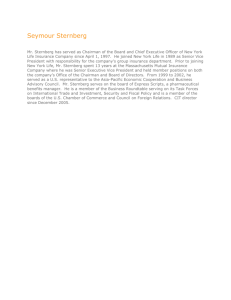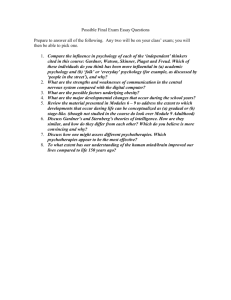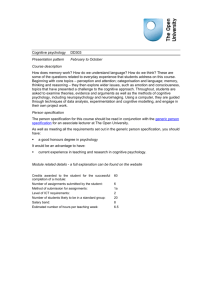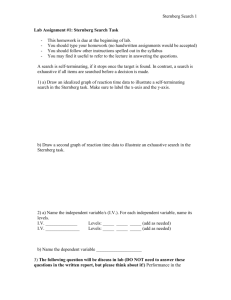Cognitive Psychology, Sixth Edition, Robert J. Sternberg Chapter 2
advertisement
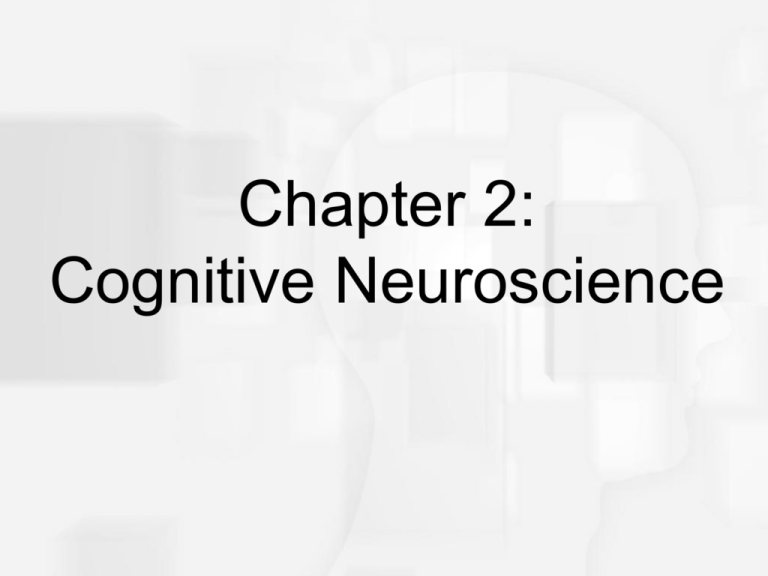
Cognitive Psychology, Sixth Edition, Robert J. Sternberg Chapter 2 Chapter 2: Cognitive Neuroscience Cognitive Psychology, Sixth Edition, Robert J. Sternberg Chapter 2 Some Questions of Interest • What are the fundamental structures and processes of the human brain? • How do researchers study the major structures and processes of the brain? • What have researchers found as a result of studying the brain? Cognitive Psychology, Sixth Edition, Robert J. Sternberg Chapter 2 Anatomy of the Brain Cognitive Psychology, Sixth Edition, Robert J. Sternberg Chapter 2 Anatomy of the Brain • Forebrain – Cerebral cortex – Basal ganglia • Motor movement – Limbic system Cognitive Psychology, Sixth Edition, Robert J. Sternberg Chapter 2 Anatomy of the Limbic System • Septum & Amygdala – Involved in anger, aggression, fear • Hippocampus – memories • Thalamus – Relays sensory information to the cerebral cortex • Hypothalamus – 4 F’s Cognitive Psychology, Sixth Edition, Robert J. Sternberg Chapter 2 Midbrain • Helps to control eye movement and coordination • Reticular activating system – Controls respiration, cardiovascular function, digestion, alertness, and sleep • Brain stem – Vital in basic attention, arousal, and consciousness Cognitive Psychology, Sixth Edition, Robert J. Sternberg Chapter 2 Hindbrain • Medulla Oblongata – Breathing, swallowing, and digestion • Pons – Relay station • Cerebellum – Motor coordination, posture, and maintaining balance Cognitive Psychology, Sixth Edition, Robert J. Sternberg Chapter 2 Lobes of the Cerebral Cortex Cognitive Psychology, Sixth Edition, Robert J. Sternberg Chapter 2 Cerebral Cortex • Contralaterality • Corpus Callosum – Neural fibers connecting left and right lobes – Allows communication between right and left side Cognitive Psychology, Sixth Edition, Robert J. Sternberg Chapter 2 Cerebral Cortex: localization and specialization Cognitive Psychology, Sixth Edition, Robert J. Sternberg Chapter 2 Hemispheric Activity Interferes With Ability to Work a Counter Cognitive Psychology, Sixth Edition, Robert J. Sternberg Chapter 2 Specialization of Left Hemisphere • Wernicke’s area vs. Broca’s area Cognitive Psychology, Sixth Edition, Robert J. Sternberg Chapter 2 Split-Brain Demonstration What would a split-brain patient say they saw? What would a split-brain patient point to with their left hand? Cognitive Psychology, Sixth Edition, Robert J. Sternberg Chapter 2 Brain Disorders Capgrass syndrome Phantom limb Synesthesia • http://www.ted.com/talks/vilayanur_ramachandran _on_your_mind.html Cognitive Psychology, Sixth Edition, Robert J. Sternberg Chapter 2 Structure of a Neuron Cognitive Psychology, Sixth Edition, Robert J. Sternberg Chapter 2 Neurotransmitters Chemical messengers •Acetylcholine = associated with Alzheimer’s disease •Dopamine = associated with schizophrenia and Parkinson’s disease •Serotonin = associated with anorexia Cognitive Psychology, Sixth Edition, Robert J. Sternberg Chapter 2 Group Reaction Time and Neural Speed Cognitive Psychology, Sixth Edition, Robert J. Sternberg Chapter 2 Viewing Structures and Functions of the Brain Cognitive Psychology, Sixth Edition, Robert J. Sternberg Chapter 2 Animal Studies • Single-cell recordings • Selective lesioning • Genetic knockout procedures • Create animals that lack certain kinds of cells or receptors in the brain Cognitive Psychology, Sixth Edition, Robert J. Sternberg Chapter 2 Human Studies • Electrical recordings • Event-related potential (ERP) Cognitive Psychology, Sixth Edition, Robert J. Sternberg Chapter 2 Human Studies • Static imaging techniques – Angiogram CT scan; MRI scan Cognitive Psychology, Sixth Edition, Robert J. Sternberg Chapter 2 Metabolic Imaging • Positron emission tomography (PET) – Radioactive material is injected or inhaled – Participant is then scanned to produce an image of the brain’s activity Cognitive Psychology, Sixth Edition, Robert J. Sternberg Chapter 2 Metabolic Imaging • Functional magnetic resonance imaging (fMRI) – Takes a series of images of the brain in quick succession – Brain areas with more blood flow have been shown to have better visibility Cognitive Psychology, Sixth Edition, Robert J. Sternberg Chapter 2 Metabolic Imaging • Transcranial magnetic stimulation (TMS) – Temporarily disrupt functioning of a particular brain area – An electrical current passes through a coil on person’s head, generating a magnetic field Cognitive Psychology, Sixth Edition, Robert J. Sternberg Chapter 2 Metabolic Imaging Magnetoencephalography (MEG) – Measures activity of the brain from outside the head by picking up magnetic fields emitted by changes in brain activity Cognitive Psychology, Sixth Edition, Robert J. Sternberg Chapter 2 Brain Disorders • Stroke • Brain tumor • Head injuries http://www.ted.com/talks/jill_bolte_taylor_s_powerfu l_stroke_of_insight.html
